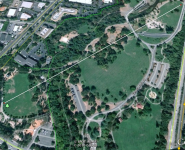Good question, that. I'll admit to being a silver nut, albeit not nearly in the same league as Angel or Jack. :ticked:
I never dig Zincolns...period. If I do, it was a mistake in my pre-dig decision process. I realize that this snobish attitude results in missed good targets such as class rings, etc. However, with my detector I can usually identify something in that VDI range that is not a Zincoln. Avoiding Zincolns simply provides more time to hunt for better targets.
Quarters and dimes are a different story. In northern California and southern Nevada (two places where I do most of my coinshooting), the soil is highly mineralized. As a result, a silver and a clad dime or quarter can have VDI numbers that are often so close that I can't distinguish between them. Therefore, I dig everything that is above +70...resulting in a lot of clad.

In the Silicon Valley area of northern California, most of the older (pre-1970 is old in Ca.) parks had a ton of $$$ thrown into them during the dot-com era in the form of added topsoil to make them more appealing to the tender California lifestyle.

In these parks, depth is the major factor in finding silver coins. While I don't subscribe to the theory that coins sink much in areas that never freeze and thaw, adding 6-10 inches of topsoil forces the detectorist to think ":grin:envious:EP if he's going to have a high silver return on his efforts.
The park in the attached pic is a perfect example. It dates back to the early 50's, but was completely re-landscaped in the mid-1980's. It's large (the white line is almost a half mile long), and has rewarded my silver quest considerably. When I hunt the
open areas of that park, I don't even bother to dig any potential coin target that is less than six inches deep...it simply isn't worth the effort IMHO.
Today's detectors are, by and large, much deeper than earlier models. It is possible that detectorists twenty years ago recovered shallower silver in those areas. However, I doubt it. Silver coins dropped before the influx of topsoil simply were beyond the range of their machines after the additional soil was added.
I don't mean to imply that I don't dig shallow targets around older trees and sidewalks. I'm referring to the open areas. Often the addition of topsoil stopped as the machinery approached trees...that's when I get busy and dig the shallower targets.
Without getting off the subject too much, here's an interesting tip that I discovered when hunting parks that have had a lot of topsoil added...
Look for a mound in the park. Often the added topsoil is not as deep as elsewhere in the general area.
Wow!!! This post was longer than I expected. (Silver nuts are that way. :yes: )
